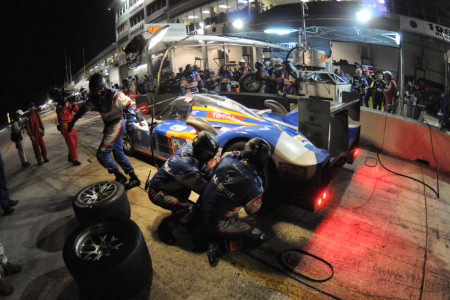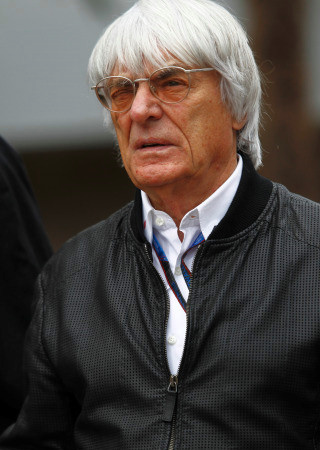The Way it Is/ Adapting to a changing world
by Gordon Kirby Sorry I missed Sebring again this year but my book and other duties kept me anchored here in New Hampshire. As expected the European teams dominated the race with Hugues de Chaunac's ORECA team scoring an emotional win for Peugeot after the factory Peugeots and Audis were delayed by a series of incidents. Kudos to Duncan Dayton's Highcroft team on an excellent run to second place with its latest HPD ARX-01e gasoline P1 car and to Rob Dyson's team for a dogged drive to sixth place with its Lola-Mazda. Congratulations also to Bobby Rahal's BMW Team RLL impressive one-two sweep in the extremely competitive GT category.
Sorry I missed Sebring again this year but my book and other duties kept me anchored here in New Hampshire. As expected the European teams dominated the race with Hugues de Chaunac's ORECA team scoring an emotional win for Peugeot after the factory Peugeots and Audis were delayed by a series of incidents. Kudos to Duncan Dayton's Highcroft team on an excellent run to second place with its latest HPD ARX-01e gasoline P1 car and to Rob Dyson's team for a dogged drive to sixth place with its Lola-Mazda. Congratulations also to Bobby Rahal's BMW Team RLL impressive one-two sweep in the extremely competitive GT category.
It's good to see Sebring regain its old international stature these days thanks to its deserved reputation as a test race for the Le Mans 24 Hours and inclusion in the new Intercontinental Le Mans Cup series. The race has been on the comeback trail for some years now and its alliance with the ACO's Intercontinental Cup should ensure its success for many years to come. I join Audi's racing boss Dr. Wolfgang Ulrich and many others in hoping that FIA president Jean Todt soon will transform the ILMC into a fully-fledged FIA World Sports Car Championship.
When I first covered Sebring back in 1974 the 12 Hours had become an IMSA race for GT cars. From its founding in 1952 through 1972 Sebring was a round of the World Sports Car championship. But starting in 1973 when IMSA began sanctioning the race it lost its world championship status.
Still, IMSA and the 12 Hours remained pretty healthy through the seventies and eighties before hitting trouble in the mid-nineties, followed by a recovery into the modern ALMS era under Don Panoz's ownership and direction. Today, the ALMS is anchored by Sebring and Road Atlanta's season-closing Petit Le Mans, ILMC races both. The rest of the ALMS series relies on committed private entrants like Duncan Dayton and Rob Dyson and a strong GT field. It's a good show, but not a great one.

© Paul Webb
Essentially the best from the SCCA and USAC coalesced under CART's emerging new banner and through the eighties and nineties I found myself covering almost every CART race, not only for Autosport, but for many other weeklies or monthlies from Competition Press and On-Track to Indy Car Racing, AutoWeek, Racer and Road & Track. At On-Track, IndyCar Racing and Racer, I was part of the founding teams who launched the magazines and I covered not only Indy car racing but also some NASCAR, F1 and sports car races. There were also quite a few other jobs around the world from columns about Nigel Mansell's 1993-'94 Indy car exploits for London's Sunday Times to writing a monthly, two-page Honda advertorial in NewsWeek's Pacific Rim edition and various pieces in Japanese magazines.
But through the first decade of the new century all that work rapidly eroded, then went away. This was partially due to the changes wrought on the newspaper and magazine business by the internet. But in large part it was because of Indy car racing's steady decline in the market thanks to fifteen years of civil war. People wanted to read about sport, not politics, and neither of the duelling Indy car series thrived. As we all know, the IRL had its moments but struggled while CART fell into decline, then failed. Its replacement, Champ Car, stumbled along for a few years before it was absorbed by the IRL. Over that time the picture changed radically for the sport as well as for me personally.
Jobs covering Indy car racing dwindled, then vanished. As an example, today both Autosport in the UK and Autosprint in Italy cover all but the Indy 500 by watching the races on TV and the internet from their offices in London and Milan, then writing their stories from there rather then sending a writer or paying a freelancer a small fee. That's because the audience for the sport has dwindled so it doesn't require more indepth coverage like it used to through the eighties and nineties and like Formula 1 continues to enjoy in many newspapers and magazines around the world.
Nor is it just racing specialists like me who've witnessed big changes in our work. Over the past decade many longtime reporters who covered the racing beat for the nation's newspapers have retired or taken buy-outs and not been replaced. Racing is well down the list of priorities for today's cash-strapped newspapers and its easier and cheaper for them to cover the sport using old reliable AP.
Last fall, a few days after Dario Franchitti wrapped-up his second consecutive IndyCar title, Chip Ganassi told me a quiet story. I've been boring Chip for years with grumbles about the decline of Indy car racing's press corps and he chuckled as he let me know he's taken the message entirely on board.

© LAT USA
As these changes occured over the past decade I responded by shifting my focus, concentrating more on writing books and joining the revitalized Motor Sport magazine in 2008 as US editor. Motor Sport is the world's oldest auto racing magazine of course, founded in 1924, and under its most recent ownership Motor Sport is acknowledged by many fans as the world's finest racing publication.
It's a pleasure to write regularly for such a beautifully-produced magazine with a great team of writers under the direction of our editor in chief Nigel Roebuck and editor Damien Smith. My job as Motor Sport's US editor is to write a monthly column and a feature covering as wide a range of the sport as possible with a focus on history and an eye to the future. I also write a weekly blog for Motor Sport's website. By the way, I highly recommend the podcast posted last week at www.motorsportmagazine.co.uk with Dario Franchitti in conversation with Nigel, Damien and the editorial team in London.
Meanwhile, I've been assigned to cover just one IndyCar race this year--the Indy 500. I will go to Long Beach for old times sake because I've never missed Long Beach since covering the first race for F5000 cars back in 1975. And I'll go to my local track, Loudon, New Hampshire, in August for the return of IndyCar to New England after a twelve year absence. But again, my focus these days for both Motor Sport and potential book projects is the broader range of racing and the sport's great history.
Still, the challenge remains for Randy Bernard to recapture some of Indy car racing's old excitement and rebuild a media base in company with the fan base. I don't have to tell any of you how much more TV time NASCAR enjoys compared to IndyCar or any other form of the sport in the United States. Nor do I have to remind you that Formula One profits from a huge global TV market carefully nurtured over the years by Bernie Ecclestone. In contrast IndyCar has fallen to become one of America's least-watched sports and it's clear that Randy Bernard's biggest challenge is to attract much more media coverage for IndyCar, not an easy job in today's world.
This problem was brought into focus at last week's IndyCar open test at Barber Motor Sport Park where USA Today's Nate Ryan asked Bernard about the absence of Paul Tracy, Tony Kanaan and Dan Wheldon from this year's IndyCar field. Bernard responded by talking specifically about Tracy saying the Canadian doesn't sell tickets and adding that neither he nor any of the current drivers have been able to create emotional attachments with the fans. Ryan wrote about it in USA Today and the next day Bernard did some damage control telling Robin Miller on Speedtv.com that he had misspoken and that Tracy was a big draw.
"I was simply trying to point out how tough it's been getting people to attend or watch our season finale," Bernard said. "We're the best-kept secret in sports and it's my job to bring excitement and produce good TV shows that drive up our ratings and fill the seats.
"But I want to clarify that I think PT is a great ambassador for our sport. His outgoing personality is exactly what I've been talking about and I've tried to help him find sponsorship and will continue to. I want him in our series."

© LAT USA
On Sunday night Tracy's deal with Penske hung in the balance but PT at least has a deal to race in the Indy 500 with another team. This agreement should be announced today (Monday).
"It'll get me in the big race," Tracy said. "I'm not having to bring any money. It's a paying gig and I don't have to worry about bringing any sponsorship. This team is also prepared to talk about me running some more races. But I'd prefer to do it with Jay's team. But right now all that's up in the air. We'll have to wait and see."
And of course, Kanaan has made a deal to drive for KV Racing which should be confirmed any day now. What a scramble to fill-out the field!
Meanwhile, Danica aside, Tracy probably is IndyCar's biggest draw, certainly for both Canadian races in Toronto and Edmonton. He's a former champion who's won more races than any other active driver and always speaks his mind. Many fans take delight in Tracy. Others dislike or hate him so that even in today's reduced IndyCar market any sponsor is sure to get plenty of mileage out of PT.
Finally, it's important to note this week that Bernie Ecclestone has staked out his turf as an opponent of the FIA's plans to introduce a 1.6 liter four-cylinder turbo formula in 2013 and push 'green' technology in Formula One. Ecclestone said last week that he's worried the turbo four cylinder engines won't produce the shrieking sound for which F1 is renowned. Ecclestone also said he doesn't think F1 should seriously pursue 'green' technology.
Bernie's comments suggest a growing battle over philosophy and power with FIA president Jean Todt who is a big advocate of turbo four-cylinder engines and 'green' technology. Todt has been working with many of the world's auto manufacturers to define the FIA's technical way forward and my sources tell me the new 'green' turbo four formula for 2013 will bring Honda and Toyota back to F1 as engine suppliers. I'm also told that Honda and Toyota will be joined by both Hyundai and VW, the latter most likely through its Porsche brand.
So it will be interesting to see how successful Todt is in pushing forward his agenda. Can Ecclestone thwart him and continue to rule F1, despite his age? Or is it possible that Bernie has met his match? On second thought....
Auto Racing ~ Gordon Kirby
Copyright 2011 ~ All Rights Reserved
Copyright 2011 ~ All Rights Reserved
Top of Page